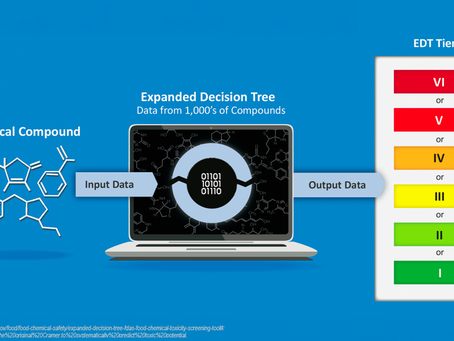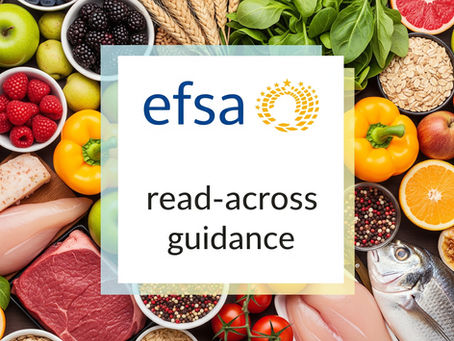top of page


The Hidden Variability in Genotoxicity Data and the Future of NAMs
Ready to Master Genotoxicity Prediction? Understanding the uncertainties of reference data is the first step toward building more robust and scientifically sound NAM strategies. ToxNavigation is at the forefront of this shift. We are excited to announce the 2026 release of our new in-depth training course: "NAMs - QSAR and read-across to predict genotoxicity" This course is designed to equip expert toxicologists with the practical skills to apply in silico methods for genot

Elena Fioravanzo
2 days ago2 min read


The FDA's Expanded Decision Tree (EDT) – A New Era for Food Chemical Safety Screening
The U.S. Food and Drug Administration (FDA) has unveiled its Expanded Decision Tree (EDT) , a significant modernization of the classic Cramer Decision Tree. As toxicologists, we understand the increasing need for efficient, structure-based methods to screen the vast number of chemicals in the food supply, especially those with limited existing safety data. The EDT is the FDA's new tool for this, marking a step forward in the use of computational toxicology (also known as in

Elena Fioravanzo
Dec 52 min read


Comparative study of (Q)SAR models for predicting the environmental fate of cosmetic ingredients: Persistence, bioaccumulation, and mobility
The regulatory landscape for the cosmetics industry continues to evolve, placing a heightened focus on the environmental fate of ingredients—specifically their Persistence (P), Bioaccumulation (B), and Mobility (M). With the EU ban on animal testing, (Quantitative) Structure-Activity Relationship ((Q)SAR) models and other New Approach Methodologies (NAMs) have become indispensable for filling critical data gaps. We are delighted to highlight a highly valuable and well-execu

Elena Fioravanzo
Oct 132 min read


Navigating the Future of Cosmetic Safety: An Overview of In Silico Tools for Hazard Assessment
Read our full paper in Chemical Research in Toxicology and explore our training courses to advance your skills in computational...

Elena Fioravanzo
Sep 183 min read


EFSA's New Guidance on Read-Across: A Landmark for Food & Feed Safety and Why Our Training Aligns Perfectly
The European Food Safety Authority (EFSA) has taken a significant step forward in chemical safety assessment with the publication of its...

Elena Fioravanzo
Aug 182 min read


Enhancing Genotoxicity Assessment: New Insights on OECD QSAR Toolbox Profilers
In the evolving landscape of chemical safety and regulatory toxicology, Quantitative Structure-Activity Relationship (QSAR) models and in...

Elena Fioravanzo
Jul 172 min read


Beyond Predictions: Why Benchmarking Computational Tools for Toxicokinetic and Physicochemical Properties is Essential
In the world of cheminformatics and toxicology, computational tools have become indispensable for predicting a vast array of chemical...

Elena Fioravanzo
May 262 min read


Understanding Nitrosamine Limits: A Key Paper on the CPCA, Highlighted at SOT and Soon Part of Our ICH M7 Training
Following an insightful presentation by Dr. N. Kruhlak (US FDA) at the recent Society of Toxicology (SOT) conference, "The Evolution of...

Elena Fioravanzo
May 132 min read


Join Us at the BTS Congress 2025 (May 7th - 9th)! Unlocking Enhanced QSAR Predictions for Regulatory Toxicology
We're excited to announce our participation in the upcoming British Toxicology Society (BTS) Congress 2025 , taking place from May 7th to...

Elena Fioravanzo
May 12 min read


🎉 Congratulations to Our Prize Draw Winner! 🎉
Following your participation in our Price Draw by enrolling in our Taster Session at SOT 2025, we are thrilled to announce that...

Elena Fioravanzo
Mar 201 min read


Win FREE Enrollment in Our eLearning Course at SOT 2025! 🎉
Are you attending SOT 2025 in Orlando? Don't miss your chance to win FREE access to our eLearning course: NAMs – Use and Application of...

Elena Fioravanzo
Feb 171 min read


Meet ToxNavigation at SOT 2025 in Orlando!
We are excited to announce that ToxNavigation will be exhibiting at the 64th Annual Meeting and ToxExpo of the Society of Toxicology...

Elena Fioravanzo
Feb 171 min read


The Evolution and Challenges of QSAR Modelling in Toxicology – A Closer Look at Recent Advances
The famous quote by Paul Ehrlich, “To err is human; to really foul things up requires a computer,” humorously encapsulates the challenges...

Elena Fioravanzo
Feb 53 min read


Enhancing Transparency in the Cramer Classification Scheme: Insights from a Recent Study
For those looking to deepen their understanding of the use of tools such as ToxTree or the OECD QSAR ToolBox, I highly recommend checking...

Elena Fioravanzo
Jan 183 min read


Understanding Uncertainty in Computational Toxicology: A Key Step Toward Reliable Predictions
As computational toxicology advances, its role in predicting chemical toxicity is becoming essential in contemporary safety evaluations....

Elena Fioravanzo
Dec 9, 20242 min read


Maximize Your Training Budget with ToxNavigation's In Silico Toxicology Courses
Do you have a training budget that needs to be spent before year-end? Enroll to train your toxicologists, chemists, and regulatory...

Elena Fioravanzo
Dec 2, 20241 min read


Sisley and ToxNavigation Showcase In Silico Innovations at SFT 2024
📢 ToxNavigation is honored to be co-authors of two posters featured at the Congrès du Cinquantenaire de la SFT: Évolutions, Innovations...

Elena Fioravanzo
Nov 11, 20241 min read


In silico toxicology training course - 2024
We are pleased to announce the full 2024 version of our “ NAMs – Use and Application of QSAR and Read-across ” course is now published...

Elena Fioravanzo
Oct 16, 20241 min read


Enhancing Toxicity Prediction: A Deep Dive into Applicability Domains for Read-Across in Computational Toxicology
In the ever-evolving field of computational toxicology, the use of read-across approaches to predict the toxicity of chemicals has gained...

Elena Fioravanzo
Aug 26, 20242 min read


The Crucial Role of Chemical Similarity in Clustering and Classification Approaches for Toxicology
For those looking to deepen their understanding of molecular description and structural similarity in toxicological assessments, I highly...

Elena Fioravanzo
Aug 7, 20243 min read
bottom of page